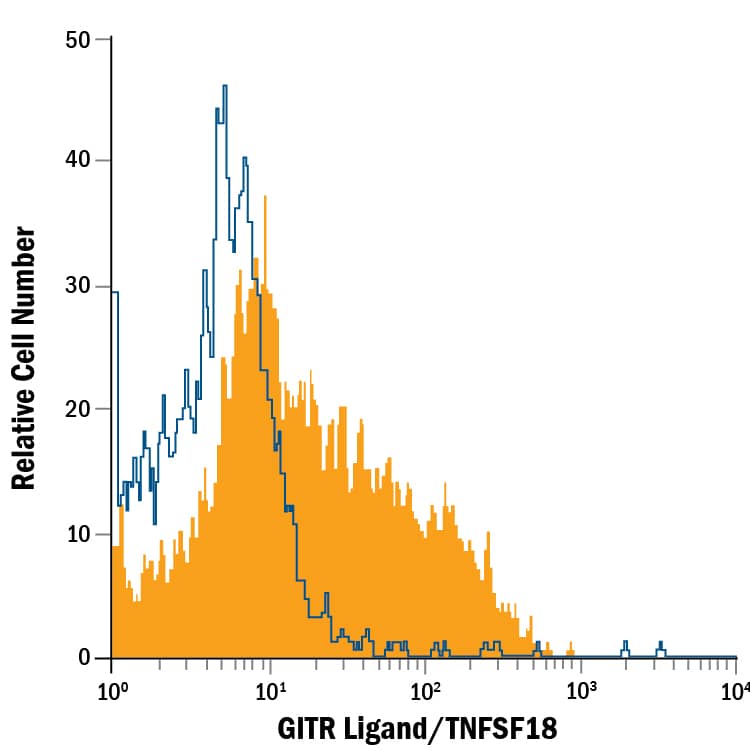Human GITR Ligand/TNFSF18 Fluorescein-conjugated Antibody
R&D Systems, part of Bio-Techne | Catalog # FAB6941F


Key Product Details
Species Reactivity
Validated:
Cited:
Applications
Validated:
Cited:
Label
Antibody Source
Product Specifications
Immunogen
Glu52-Ser177
Accession # Q9UNG2
Specificity
Clonality
Host
Isotype
Scientific Data Images for Human GITR Ligand/TNFSF18 Fluorescein-conjugated Antibody
Detection of GITR Ligand/TNFSF18 in Human Umbilical Vein Endothelial Cells (HUVEC) by Flow Cytometry.
Human umbilical vein endothelial cells were stained with Mouse Anti-Human GITR Ligand/TNFSF18 Fluorescein-conjugated Monoclonal Antibody (Catalog # FAB6941F, filled histogram) or isotype control antibody (Catalog # IC002F, open histogram). View our protocol for Staining Membrane-associated Proteins.Applications for Human GITR Ligand/TNFSF18 Fluorescein-conjugated Antibody
Flow Cytometry
Sample: Human umbilical vein endothelial cells (HUVEC)
Formulation, Preparation, and Storage
Purification
Formulation
Shipping
Stability & Storage
- 12 months from date of receipt, 2 to 8 °C as supplied.
Background: GITR Ligand/TNFSF18
GITR (glucocorticoid-induced TNF receptor superfamily-related protein, also named AITR, activation-inducible TNF receptor superfamily-related protein) and GITR ligand (GITRL) are novel members of the TNF receptor (TNFR) and TNF superfamilies (SF) that have been designated TNFRSF18 and TNFSF18, respectively. Human GITRL cDNA encodes a 177 amino acid residues type II membrane protein. The carboxy-terminal extracellular domain shows sequence identity to TNF/TNFSF2 (21%), Fas ligand/TNFSF6 (21%), TRAIL/TNFSF10 (18%), and lymphotoxin alpha/TNFSF1 (18%). GITRL is constitutively expressed in human umbilical vein endothelial cells but is not expressed in resting or stimulated T cell lines, B cell lines or peripheral blood mononuclear cells. GITR, the receptor for GITRL, is expressed at low levels in peripheral blood T cells, bone marrow, thymus, spleen and lymph nodes. In contrast to mouse GITR, expression of human GITR is not induced by treatment with dexamethasone, but is up-regulated by antigen-receptor stimulation or by treatment with soluble anti-CD3 plus anti-CD28 or PMA plus ionomycin. Ligation of GITR has been found to induce nuclear factor (NF)-kappa B activation via TNF receptor-associated factor 2 and protect cells from TCR activation-induced cell death. It has been proposed that GITRL and GITR may modulate T lymphocyte functions in peripheral tissues.
References
- Nocentini, G. et al. (1997) Proc. Natl. Acad. Sci. USA 94:6216.
- Kwon, B. et al. (1999) J. Biol. Chem. 274:6056.
- Gurney, A.L. et al. (1999) Current Biology 9:215.
- Kwon, B. et al. (1999) Current Opinion in Immunology 11:340.
Long Name
Alternate Names
Gene Symbol
UniProt
Additional GITR Ligand/TNFSF18 Products
Product Documents for Human GITR Ligand/TNFSF18 Fluorescein-conjugated Antibody
Product Specific Notices for Human GITR Ligand/TNFSF18 Fluorescein-conjugated Antibody
For research use only